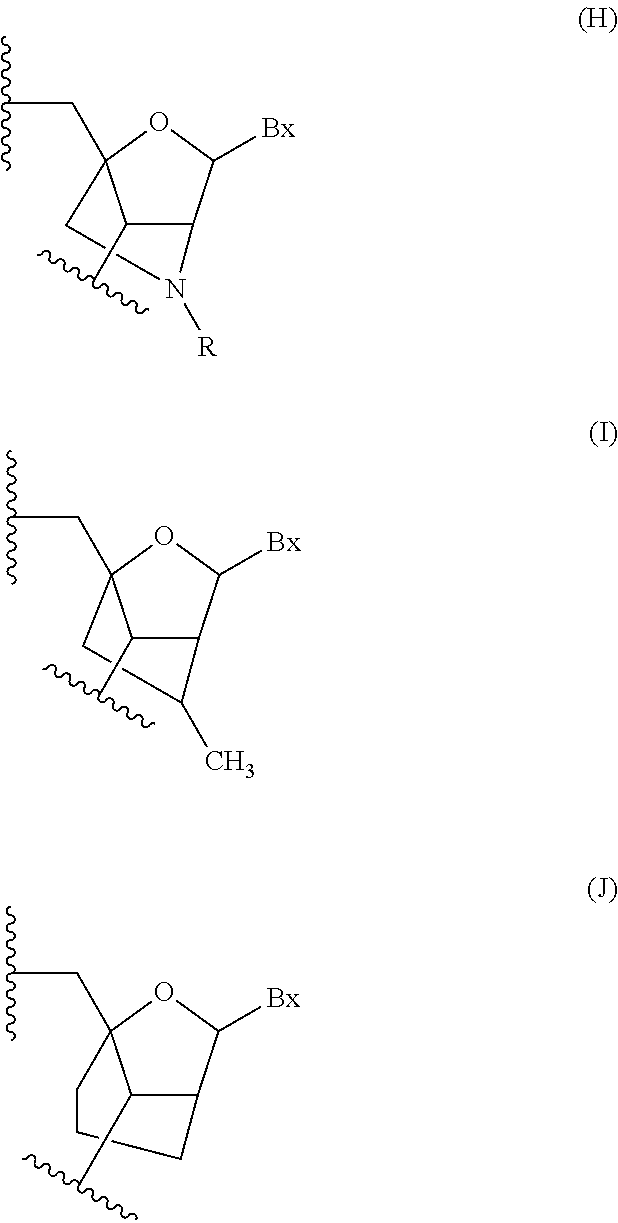Modulation of apolipoprotein ciii (apociii) expression
a technology of apolipoprotein ciii and apolipoprotein ciii, which is applied in the field of modulation of apolipoprotein ciii (apociii) expression, can solve the problems of increasing the risk of acute pancreatitis, pancreatitis, and life-threatening conditions, and achieves the effect of improving the ratio of tg to hdl
- Summary
- Abstract
- Description
- Claims
- Application Information
AI Technical Summary
Benefits of technology
Problems solved by technology
Method used
Image
Examples
example 1
Effect of In Vivo Antisense Inhibition of Human ApoCIII in huApoCIII Transgenic Mice
[0401]Transgenic mice with the human ApoCIII transgene utilized in the study were the progeny of huApoCIII transgenic F1 hybrids (Jackson Laboratories, CA) and C57BL / 6 mice. ISIS 304801 (previously disclosed in U.S. Pat. No. 7,598,227) with a start site of 508 on SEQ ID NO: 1 (GENBANK Accession No. NM—000040.1) and a start site of 3139 on SEQ ID NO: 2 (GENBANK Accession NT—033899.8 truncated from nucleotides 20263040 to 20266203), with the sequence 5′-AGCTTCTTGTCCAGCTTTAT-3′ (SEQ ID NO: 3) and a 5-10-5 MOE gapmer motif was utilized in this assay. Another ISIS antisense oligonucleotide, ‘Compound X’, with a 5-10-5 MOE gapmer motif, targeting another region of SEQ ID NO: 1 or SEQ ID NO: 2, was also included in this assay. Another ISIS antisense oligonucleotide, ‘Compound Y’, with a 5-10-5 MOE gapmer motif, targeting a rodent ApoCIII sequence (GenBank Accession No. NM—023114.3; SEQ ID NO: 5) was also in...
example 2
Dose-Dependent Antisense Inhibition of Human ApoCIII in huApoCIII Transgenic Mice
[0407]ISIS 304801 and Compound X were further studied in a dose-dependent study using human ApoCIII transgenic mice.
Treatment
[0408]Human ApoCIII transgenic mice were maintained on a 12-hour light / dark cycle and fed ad libitum Teklad lab chow. Animals were acclimated for at least 7 days in the research facility before initiation of the experiment. Antisense oligonucleotides (ASOs) were prepared in PBS and sterilized by filtering through a 0.2 micron filter. Oligonucleotides were dissolved in 0.9% PBS for injection.
[0409]Female mice were divided into nine treatment groups consisting of 3 mice each. Eight such groups received subcutaneous injections of ISIS 304801 or compound X at a dose of 1.5 mg / kg / week, 5 mg / kg / week, 15 mg / kg / week, or 50 mg / kg / week for 2 weeks. One group of mice received subcutaneous injections of PBS for 2 weeks. Prior to the treatment as well as after the last dose, blood was withdraw...
example 3
Effect of Antisense Inhibition of ApoCIII in CETP Transgenic LDL Receptor Null Mice
[0412]Compound Y was further studied in a human CETP transgenic LDLr− / − mouse model to examine the effects of a mouse ApoCIII antisense inhibitor on plasma lipids and lipoprotein metabolism in hyperlipidemic mice.
Treatment
[0413]Human CETP transgenic LDLr− / − transgenic mice were maintained on a 12-hour light / dark cycle and fed ad libitum a western diet (42% calories from fat, 0.2% cholesterol). Animals were acclimated to this diet for 10 days in the research facility before initiation of the experiment. Antisense oligonucleotides (ASOs) were prepared in PBS and sterilized by filtering through a 0.2 micron filter. Oligonucleotides were dissolved in 0.9% PBS for injection.
[0414]Eight week old male mice were divided into three treatment groups. One such group of 6 mice received subcutaneous injections of compound Y at a dose of 12.5 mg / kg / week for 4 weeks. One group of 4 mice received subcutaneous injecti...
PUM
| Property | Measurement | Unit |
|---|---|---|
| Fraction | aaaaa | aaaaa |
| Fraction | aaaaa | aaaaa |
| Density | aaaaa | aaaaa |
Abstract
Description
Claims
Application Information
 Login to View More
Login to View More - R&D
- Intellectual Property
- Life Sciences
- Materials
- Tech Scout
- Unparalleled Data Quality
- Higher Quality Content
- 60% Fewer Hallucinations
Browse by: Latest US Patents, China's latest patents, Technical Efficacy Thesaurus, Application Domain, Technology Topic, Popular Technical Reports.
© 2025 PatSnap. All rights reserved.Legal|Privacy policy|Modern Slavery Act Transparency Statement|Sitemap|About US| Contact US: help@patsnap.com



